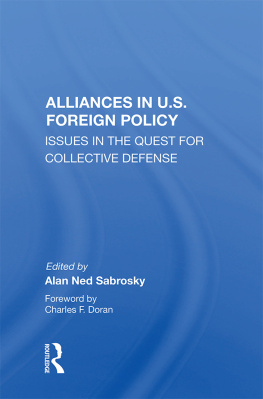Research in Strategic Alliances
T. K. Das, Series Editor
Published
Researching Strategic Alliances: Emerging Perspectives (2010)
Edited by T. K. Das
Strategic Alliances in a Globalizing World (2011)
Edited by T. K. Das
Behavioral Perspectives on Strategic Alliances (2011)
Edited by T. K. Das
Strategic Alliances for Value Creation (2012)
Edited by T. K. Das
Management Dynamics in Strategic Alliances (2012)
Edited by T. K. Das
Managing Knowledge in Strategic Alliances (2013)
Edited by T. K. Das
Interpartner Dynamics in Strategic Alliances (2013)
Edited by T. K. Das
Managing PublicPrivate Strategic Alliances (2014)
Edited by T. K. Das
Strategic Alliances for Innovation and R&D (2014)
Edited by T. K. Das
Managing Multipartner Strategic Alliances (2015)
Edited by T. K. Das
Strategic Alliances for SME Development (2015)
Edited by T. K. Das
Governance Issues in Strategic Alliances (2016)
Edited by T. K. Das
Managing Alliance Portfolios and Networks (2017)
Edited by T. K. Das
Managing Trust in Strategic Alliances (2018)
Edited by T. K. Das
Managing Interpartner Risks in Strategic Alliances (2019)
Edited by T. K. Das
Managing the Partners in Strategic Alliances (2021)
Edited by T. K. Das
In Development
Managing Interpartner Cooperation in Strategic Alliances
Edited by T. K. Das
_______________________________________
Managing the Partners in Strategic Alliances
_____
edited by
T. K. Das
City University of New York
INFORMATION AGE PUBLISHING, INC.
Charlotte, NC www.infoagepub.com
Library of Congress Cataloging-in-Publication Data
A CIP record for this book is available from the Library of Congress
http://www.loc.gov
ISBN: 978-1-64802-590-7 (Paperback)
978-1-64802-591-4 (Hardcover)
978-1-64802-592-1 (E-Book)
Copyright 2021 Information Age Publishing Inc.
All rights reserved. No part of this publication may be reproduced, stored in a
retrieval system, or transmitted, in any form or by any means, electronic, mechanical, photocopying, microfilming, recording or otherwise, without written permission
from the publisher.
Printed in the United States of America
_________________________________________
Managing the Partners in Strategic Alliances
_____
A volume in
Research in Strategic Alliances
T. K. Das, Series Editor
Foreword to the Series
Relationships have been important to commercial activity and economic transactions for thousands of years. Yet, the development of a competitive global landscape has substantially enhanced the importance of partnerships between economic entities. These partnerships, referred to as strategic alliances, provide access to resources and capabilities that allow firms to gain economies of scope and to increase their productivity and innovation. The economies, productivity, and innovations are necessary to at least maintain competitive parity, and especially to achieve a competitive advantage in the often highly competitive global markets. Strategic alliances have also become a prominent means of entering new markets, especially foreign markets. Therefore, alliances and the networks of firms of which they are a part, have become essential to conducting business for all types of firms: large, small, established and new.
Because of their growing importance, research on strategic alliances has increased markedly in the last two decades. Yet, there is a need for an authoritative compendium of strategic alliance research and knowledge. This book series on Research in Strategic Alliances fills this critically important gap in the field. It provides a thorough examination of significant topics that provide complete and up-to-date knowledge on strategic alliances. This book series can serve as a catalyst for the more effective management of strategic alliances, and will guide future research on them. I commend it to you.
Michael A. Hitt
Distinguished Professor and Joe B. Foster Chair in Business Leadership
at Texas A&M University, and Past President of the Academy
of Management and the Strategic Management Society.
About the Series
The globalization of markets has led to an increased interdependence among business firms, resulting in an explosion in the number of strategic alliances. Strategic alliances, briefly, are cooperative arrangements aimed at achieving the strategic objectives of two or more partner firms. These interfirm arrangements can range from joint R&D to equity-based joint ventures. However, the scholarship relating to strategic alliances remains largely dispersed in the literatures of traditional academic disciplines such as strategic management, marketing, economics, and sociology.
This book series on strategic alliances covers the essential progress made thus far in the literature and elaborate upon fruitful streams of scholarship. More importantly, the book series focuses on providing a robust and comprehensive forum for new scholarship in the field of strategic alliances. In particular, the books in the series cover new views of interdisciplinary theoretical frameworks and models (dealing with resources, risk, trust, control, cooperation, learning, opportunism, governance, developmental stages, performance, etc.), significant practical problems of alliance organization and management (such as alliance capability, interpartner conflict, internal tensions, use of information technology), and emerging areas of inquiry. The series also includes comprehensive empirical studies of selected segments of business, economic, industrial, government, and non-profit activities with wide prevalence of strategic alliances. Through the ongoing release of focused topical titles, this book series seeks to disseminate theoretical insights and practical management information that will enable interested professionals to gain a rigorous and comprehensive understanding of the field of strategic alliances.
T. K. Das
City University of New York
Series Editor, Research in Strategic Alliances
Chapter 1
Deterring Deceitful Behaviors of Alliance Partners
T. K. Das
Abstract
The purpose of this chapter is to provide decision makers in strategic alliances a risk-time framework to (a) categorize types of potential deceitful behaviors by partners, and (b) adopt appropriate deterrence mechanisms to curb and control such behavior. The chapter identifies four types of deceitful behavior, based on: the degree of relational risk that characterizes interactions of a firm with its alliance partner; and the length of the deceit horizon. It also suggests a number of deterrence mechanisms for controlling the different types of deceitful behavior, with the aim of enhancing confidence in partner cooperation in alliances. The chapter provides a practical template for alliance managers to decide what kinds of deterrence mechanisms to adopt on the basis of the type of perceived deceitful behavior of alliance partners. It also responds to an unmet need of managers with alliance responsibilities for a framework to help select the most effective mechanisms to deter different kinds of potential deceitful behavior of alliance partners.
Introduction: Need for Vigilance
About Alliance Partners
Like thorns on the stems of roses, the popularity of strategic alliances has been plagued by potential for deceitful behavior by partners. We know that alliances, or cooperative arrangements among businesses, have been growing very rapidly in recent years. However, alliances have also failed at remarkably high rates, owing to the deceitful behavior of the member firms. Deceitful behavior refers to the self-interest seeking behavior of alliance firms that involve deceit. The threat of potential deceitful behavior hinders the collaborative efforts of member firms in alliances, destroys interpartner trust and confidence, injects uncertainties about alliance performance, and leads, eventually, to alliance termination.
Next page











